
| | J A C K E T # 4 The URL address of this page is http://jacketmagazine.com/04/lehman-postmod.html back to Jacket # 4 contents page back to Jacket's homepage | |
|
|
|
 The Questions of
The Questions ofPostmodernism
What do the following have in common?
|
|
|
|
|
Kenneth Koch, New York, April 1985.
What all these have in common is that each can be said to embody the spirit of postmodernism . The first seven are relatively recent instances; the works by Ashbery, Koch, Mathews, O'Hara, and Rivers were ahead of the wave. What is it? This, the central question of postmodernism, was stated unsurpassingly by T. S. Eliot in "The Love Song of J. Alfred Prufrock." Having introduced the notion of an "overwhelming question," Eliot goes on to forbid the reader from finding out what it is: "Oh, do not ask 'What is it?'" An accurate paraphrase of the question is "What isn't it?", for in the way of any catch-all term postmodernism has come to comprise all manner of phenomena, some worthwhile, some creepy. Quit stalling. What is postmodernism? Nobody knows for sure, except you're supposed to say that before talking confidently about it. Best not to be too solemn. No one, with the exception of a few academics, really likes the term, but it won't go away, and it does afford a way to make sense of some recent developments in American fiction and poetry.
Fragments are postmodernist, as is the act of completing somebody else's unfinished work. Hoaxes by nature are postmodernist. So are pseudonyms. The Portuguese poet Pessoa, who wrote poems under many pseudonyms, each of which he outfitted with a full biography and a distinctive style, was an arch-postmodernist avant la lettre or -- to use a phrase favored by the members of the Oulipo, the French society of mathematically-inclined writers committed to the development of cunning new poetic forms -- a plagiarist by anticipation. When Jean-Paul Belmondo in Jean-Luc Godard's Breathless (1959) tries to die like Humphrey Bogart in a '30s gangster movie, he is announcing the official birth of postmodernism. (Belmondo spends much of that movie posing in front of old Bogart posters.) The patron saints of postmodernism are Jorge Luis Borges and Vladimir Nabokov, writers who favor parables, labyrinths, mirror games, riddles and linguistic oddities, false-bottomed narratives, artifice conscious of itself as artifice. The paradigmatic postmodernist gesture is the one performed by Borges's Pierre Menard, who sets out to write a book called Don Quixote that is identical in every particular to the Don Quixote of Cervantes -- word for word -- but is nevertheless superior to that of Cervantes, because it would be harder to write the book in Argentina in the twentieth century than in Spain in the sixteenth when, presumably, the medieval chivalrous ideal was closer to hand. Repetition is postmodernism in action. Everything happens twice, "the first time as tragedy, the second time as farce": Karl Marx's famous remark about history repeating itself is obligatory in any discussion of postmodernism. Games are postmodernist: the board game Clue, for one example, and the sestina verse form, for another. David Trinidad combines the two in his sestina entitled "Detective Notes," which begins with this stanza -- Mrs. White with the Candlestick in the Hall Prof. Plum with the Lead Pipe in the Lounge Col. Mustard with the Rope in the Dining Room Mrs. Peacock with the Wrench in the Kitchen Mr. Green with the Revolver in the Conservatory Miss Scarlett with the Knife in the Study -- and works variants on the formula for the next 33 lines. |
|
|
|
|
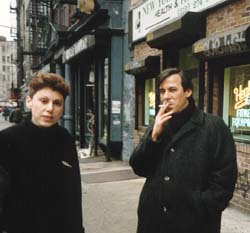 Poets Elaine Equi and David Trinidad, New York, circa 1990. Photograph copyright © John Tranter, 1998 |
|
|
|
|
Experiments in discontinuous narration are postmodernist, as is the attempt to incorporate the texture of multiplicity into fiction. Robert Coover does both at once in his famous story "The Babysitter." He constantly interrupts his narrative, scrambling the order of events, and he provides different outcomes for the same fictional predicament. You will find the ideal of multiplicity in its purest form in a novel entitled April March by the Borgesian character Herbert Quain. A purely conceptual novel by a non-existent author, April March branches out backwards: an event is described in chapter one; each of the following three chapters lays out a plausible prior event leading up to the one described in chapter one; for each of these three, three subsequent chapters detail prior events that could have led to it. Borges explains: "The entire work, thus, constitutes nine novels; each novel contains three long chapters. (The first chapter, naturally, is common to all.) The temper of one of these novels is symbolic; that of another, psychological; of another, communist; of still another, anti-communist; and so on." It is an experiment in multiplicity and at the same time a quizzing of causality, and it proffers itself in the course of several paragraphs. "The composition of vast books is a laborious and impoverishing extravagance," Borges wrote in defense of his procedures. "To go on for five hundred pages developing an idea whose perfect oral exposition is possible in a few minutes! A better course of procedure is to pretend that these books already exist, and then to offer a resume, a commentary." ¶ [see endnote 1]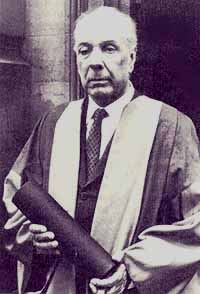 Jorge Luis Borges In some ways the postmodernist writer is in the position of the schoolteacher -- in an anecdote told by the great critic Walter Benjamin -- who gradually acquired a library by writing all the works whose titles interested him in booksellers' catalogues. It is as if all the titles were already in existence and it remains for the writer to choose among them. ¶ [see endnote 2]The spirit of postmodernism is fundamentally aesthetic in the sense propounded by Kierkegaard in Either / Or. For the aesthete, Kierkegaard writes, "boredom is a root of all evil." To overcome it, he recommends what he calls the "rotation method": "The whole secret lies in arbitrariness. People usually think it easy to be arbitrary, but it requires much study to succeed in being arbitrary so as not to lose oneself in it, but so as to derive satisfaction from it. One does not enjoy the immediate but something quite different which he arbitrarily imports into it. You go to see the middle of a play, you read the third part of a book. By this means you insure yourself a very different kind of enjoyment from that which the author has been so kind as to plan for you. You enjoys something entirely accidental; you consider the whole of existence from this standpoint; let its reality be stranded thereon." 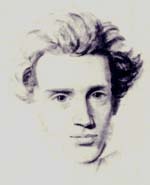
Drawing of Kierkegaard "There was a man whose chatter certain circumstances made it necessary for me to listen to. At every opportunity he was ready with a little philosophical lecture, a very tiresome harangue. Almost in despair, I suddenly discovered that he perspired copiously when talking. I saw the pearls of sweat gather on his brow, unite to form a stream, glide down his nose, and hang at the extreme point of his nose in a drop-shaped body. From the moment of making this discovery, all was changed; I even took pleasure in inciting him to begin his philosophical instruction, merely to observe the perspiration on his brow and at the end of his nose." ¶ [see endnote 3]
What Kiekegaard calls the "rotation method," we may call irony.
|
|
|
|
|
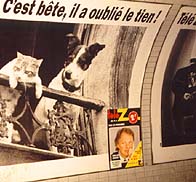 Cat: "Postmodernism? Endorse? Donnez moi une break!" Rover: "Hey, pal,take it easy, will ya?"
|
|
|
|
|
I admire many of the works I've already mentioned, but let me give an example from modern music. In his Sinfonia (1968) the composer Luciano Berio lifts the Scherzo movement from Gustav Mahler's Resurrection Symphony, treating it, in his words, "like a container within whose framework a large number of references is proliferated, interrelated and integrated into the flowing structure of the original work itself." There are allusions to Bach, Schoenberg, Debussy, Ravel, Strauss, Berlioz, Brahms, Berg, Hindemith, Beethoven, Wagner, Stravinsky, Boulez, Stockhausen, Ives, and others. Berio superimposes a chorus speaking lines taken from various sources, Samuel Beckett's The Unnamable among them. The music is rich and passionate, full of flights of elation and despair, and the juxtaposition with the text creates some remarkable explosions. With the music rushing toward a climax a male voice says, "And all this can't stop the wars, can't make the old younger or lower the price of bread," a female voice says, "say it again, louder," and he says it again, louder, and the music seems to crash like a wave against the rocks. The effect is sublime, and it doesn't diminish the Mahler; on the contrary, Sinfonia renews one's appreciation of Mahler's Scherzo at the same time as it creates something quite new out of it. How about an example of postmodernism that you utterly despise?
Did You Ever Hear "Did You Ever Have to Make Up Your Mind?" You did if you saw Michelangelo Antonioni's movie Blow-Up (1965), which has the Lovin' Spoonful's song "Did You Ever Have to Make Up Your Mind?" on its soundtrack. Blow-Up is the postmodernist apotheosis of the murder mystery. The nameless photographer played by David Hemmings in the movie is an allegorical stand-in for both the filmmaker and the viewer. He has witnessed a murder inadvertently and unconsciously. The only evidence that there has been a murder is the enlargment of a photograph he had taken thinking he was merely photographing a parkscape. The murder mystery as a genre asks, whodunnit? Blow-Up asks, what happened? And leaves the answer enshrouded in ambiguity. At the end of the movie a game of tennis is played without a ball. And as the camera pulls back, the hero watching the imaginary tennis game becomes smaller and smaller and suddenly disappears. The poignant indecisiveness of the photographer in Blow-Up makes him a postmodernist hero. It is not so much that he lacks conviction as that he suffers from a surfeit of epistemological uncertainty. There is another kind of postmodernist hero for whom it may be said, as Delmore Schwartz said of his Partisan Review colleague Philip Rahv, that he has plenty of convictions but doesn't let them stand in the way. If Bill Clinton is the first postmodernist president, that is because he seems prepared to embrace all initiatives, including contradictory ones, with no lasting allegiance to any, in a spirit of pragmatic eclecticism. The president is frequently accused of flip-flops in policy matters, but these can be seen in postmodernist terms as a ready example of what John Ashbery calls "fence-sitting raised to an esthetic ideal." What's hot and what's not? In Marshall McLuhan's terms, the Abstract Expressionists (Jackson Pollock, Willem de Kooning, Mark Rothko, Franz Kline, et al) were "hot" in the sense that radio as a medium is hot or that the personalities of Roosevelt and Churchill and Hitler were hot. An Abstract Expressionist painting was the product of great difficulty and struggle, even when that painting consisted of a single vertical stripe on a massive red canvas. The avatars of Pop Art, such as Andy Warhol and Robert Rauschenberg, who supplanted the Abstract Expressionists as the stars of the art world, were "cool" in the sense that television is cool. "You have to have time to feel sorry for yourself if you're going to be a good abstract expressionist," said Rauschenberg, for whom art meant never having to say you're sorry. As for Warhol, his soup cans and soap pads were insolently easy, nonchalant, no sweat. Other cool personalities of the early 1960s include John F. Kennedy, James Bond, Marilyn Monroe, Johnny Carson, and the Project Mercury astronauts. Modernism in this particular sense was a hot phenomenon; postmodernism, a cool one. William Butler Yeats: very hot. Robert Lowell: hot. John Ashbery: cool as a cucumber. The best way to capture McLuhan's sense of hot and cool is to compare a radio announcer's play-by-play account of a baseball game (hot) with an airy TV commentator's take on the same action (cool). Radio requires the listener's imaginative involvement; TV turns the viewer into a passive spectator. Only in the movies does a mad TV newscaster incite people to open their windows and scream their frustrations out into the street. What is the relation of postmodernism to television and the movies? Postmodernism is equally the product of disillusionment and of its opposite: the enchantment of illusions. The disillusionment is expressed through irony. The enchantment is celebrated through the movies -- through cinematic metaphors and images, narrative devices associated with the movies, or references to specific films. It is possible that T. S. Eliot introduced the cinema into poetry when he wrote of "a magic lantern throwing the nerves in patterns on a screen," but it was Frank O'Hara who put the movies into poems: "How funny you are today New York / like Ginger Rogers in Swingtime / and St. Bridget's steeple leaning a little to the left." In an early poem O'Hara likened the avid moviegoer to Leda ravished by Zeus in the form of a swan: "Our / limbs quicken even / to disgrace under / this white eye as / if there were real / pleasure in loving / a shadow and caress- / ing a disguise!" |
|
|
|
|
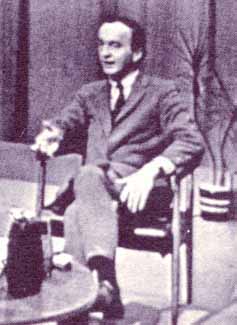 Frank O'Hara on WNDT-TV, 1964, talking with Barnett Newman. |
|
|
|
|
Film is hot. Videotape is cool. In contrast with the movies, which are associated with the glamour of nostalgia, television is identified with the present, with childhood and adolescence, and with mediocrity -- a mediocrity so perfect you'd think that TV producers and directors had consciously set their sights on it. Because television dominates the living room there is the strong sense that our reality, our public reality, is mediated: we know that the "news" is not what happens but what is reported by "the media." "Yet it is all offered as 'today's news,' as if we somehow had a right to it, as though it were a part of our lives / That we'd be silly to refuse. Here, have another -- crime or revolution? Take your pick." These lines from John Ashbery's long poem "The Skaters" (in Rivers and Mountains, 1966) imply that one way of dealing with the "news" is to refuse it. A determined effort to ignore the news or to include current events with a kind of neutral conviviality is a mark of the New York School. James Schuyler's "The Morning of the Poem" begins on "July 8 or July 9 the eighth surely, certainly 1976 that I know" and goes on to chronicle the poet's days until the end of August. Look for any mention of the televised news of that summer, which included the Republican and Democratic national conventions and the Montreal Olympic games, and you'd look in vain.  The "news" enters recent American fiction in a twisted form: where plot was, conspiracy shall be. A sense of perplexity about what is real goes together with a fascination with what is fake, simulated, spurious, constructed. A couple of years ago I read a news story about a man who manufactured replicas of the Maltese Falcon -- a fake of a fake, since the supposedly priceless, gem-encrusted piece of black avian statuary in both Dashiell Hammett's novel and John Huston's movie is a fake. The man's mail-order business was thriving.
|
|
|
|
|
Editor's note: . . . and is thriving still, on the Internet, at http://members.aol.com/maltlc/page1.htm. Let me quote: "Your own Maltese Falcon statuette . . . cast from original molds, in bonded marble, and finished in a black/bronze patina . . . The same bird that Humphrey Bogart, Sydney Greenstreet, and Peter Lorre held in their quivering hands . . . A beautiful and unique addition to any home . . . send a certified check or postal money order in the amount of $49.95 plus $7.50 s/h,(in the U.S.)." The same gentleman offers a replica set of steel balls, with reference to "Captain Quigg" [sic] of The Caine Mutiny. |
|
|
|
|
It is possible that reality never existed in unmediated form. But it is certainly the case that never before have so many people held the conviction that this is so. The emphasis shifts from the what to the how of any statement: the means and medium of communication, the telling as opposed to the tale. This was announced with deadly accuracy by McLuhan thirty years ago. But television's flattening of reality goes further. There is this paradox: nothing is real except what's on television, yet television makes everything unreal. In addition to turning viewers into laid-back voyeurs, television affords the most advanced technological means to divorce image from substance. Paranoia, a resonable response, becomes the characteristic mental condition of both the reader and the characters in postmodernist fiction. Since TV culture is the culture of the commercial and the paid political advertisement, there is always the lingering suspicion that what you see on the news was paid for, inauthentic, cooked up by some media specialist employed to fool some of the people all the time. It is not an accident that paranoia is a favorite postmodernist predicament: you get a strong dose of it in the novels of Don De Lillo and Thomas Pynchon, in the science fiction of Philip K. Dick, and in the movies of Brian de Palma in his homage-to-Hitchcock period. An outstanding TV skit from the 1980s shows us a comic impersonator of Ronald Reagan bumbling amiably outside the White House, befuddled and out of touch -- but once the reporters have left and he is safely behind closed doors, we see him clearly on top of the situation, giving orders, in complete control, a veritable tiger. In an age of irony, paranoia can have a comic edge. On the other hand, there was that memorable moment in 1983 when the editors of Newsweek decided to put the so-called Hitler diaries on the cover of the magazine. The hoax had not yet been exposed, but the writer of the cover story was taking no chances. Just in case his bosses had been conned, he wrote a perfect Newsweek sentence declaring that "it almost doesn't matter in the end" whether the diaries (for which the magazine had paid a great deal of money) turn out to be real or fake. There you have it in a nutshell, postmodernist paranoia: no way to distinguish truth from simulacrum, and in the end, someone reliably to say that it doesn't matter.
"Real Television", New York, 1997, The one really powerful episode in Oliver Stone's movie Natural Born Killers (1994) is that of the girl molested by her father, which Stone presents as if it were a situation comedy, laugh track and all. The incongruity produces a fine disturbance; in effect, Stone shows us what the paradigmatic TV family sitcom is busy repressing. That is one manifestation of the postmodernist attitude toward television. A more joyous one informs David Trinidad's poem "Reruns," which consists of seventeen haiku, each of which strictly observes the haiku's syllabic requirements, about television programs from the sixties. Postmodernism and feminism seem to have converged in the figure of the Barbie doll. Barbie is the subject of a book by M. G. Lord (Forever Barbie, 1994) and of a virtual mini-genre of poems, including "Barbie's Ferrari" by Lynne McMahon and an entire sequence entitled It's My Body by Denise Duhamel. Postmodernist hell is a comic nightmare: to be trapped inside the television, bouncing between channels, from quiz show to horse opera, as happens to Mr. and Mrs. Couch Potato in the comedy film Stay Tuned. Does the postmodernist obsession with two-dimensionality -- as if our reality lacked a dimension -- come from a steady diet of television? No, from comic books. Even before Roy Lichtenstein's "true romance" paintings of the early 1960s, with their clinching couples and thought bubbles, bright colors and Benday dots, comic strips provided infectious imagery. Cartoon characters, escaping from the cartoonist's sketch pad, are featured in big-budget Hollywood films (Superman, Batman, Dick Tracy), but they also turn up regularly in highbrow writing. John Ashbery has a poem chonicling the adventures of "Daffy Duck in Hollwood." Art Spiegelman has won major book prizes for his two-volume comic book Maus, about his parents' experience of the Holocaust, in which the Jews are mice and the Nazis cats; Spiegelman doesn't diminish the gravity of his narrative, he just translates it into a demotic idiom. Steven Millhauser has a story called "Klassik Komix #1," which renders "The Love Song of J. Alfred Prufrock" as if it were a comic book, with a paragraph of prose devoted to each panel. Nearly all of panel thirty-nine is taken up by a gigantic orange and red fruit against a black background: "The fruit has eyes and two thick black frowning eyebrows. In the lower left-hand-corner a tiny Alfred looks up at the fruit in alarm. In the thought balloon beside his head are the words: DO I DARE TO EAT A PEACH?" Millhauser's story appeared in The Barnum Museum (1990). A few months after that book appeared in print, a freelance English cartoonist named Martin Rowson published The Waste Land in the form of a comic book. Translating Eliot's poem into comic-book imagery, Rowson added a hard-boiled detective idiom; in effect he showed The Waste Land through the lens of The Maltese Falcon and The Big Sleep. The Holy Grail becomes the Maltese Falcon, the figure of Tiresias is a drag queen, and the writing is full of sarcastic similes that are just slightly off: "At dusk the buzzards started screaming like a mother whose son has blown the week's drinking money on college fees." Who put the mustache on the Mona Lisa?
|
|
|
|
|
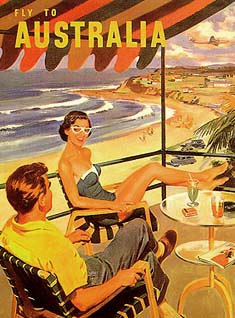
"Proust? |
|
|
|
|
We live not in the era when a painter put a mustache on the Mona Lisa but in the era when that famous gesture became a cliche -- a time when such "shocks" are routine. "But today there is no point in looking to imaginative new methods / Since all of them are in constant use," wrote John Ashbery in "Definition of Blue" (in The Double Dream of Spring, 1970). Today the spirit of irony and parody must involve our own sacred objects. That is one of the brilliant strokes in Kenneth Koch's book One Thousand Avant-Garde Plays (1988). The 112 short plays in the book exemplify the avant-garde impulse and mock it at the same time. There is an aura of cultural sexiness about being "avant-garde," though the term itself remains as slippery as ever. You can't define it, but you can demonstrate its possibilities over and over -- and that is Koch's mandate. Koch proposes, for example, six ways of turning Hamlet's "To be or not to be" soliloquy into an exemplary act of avant-garde theatre; he presents the same speech with six different sets of stage directions. In one case, the hero interrupts himself after the "sea of troubles" sentence -- he lights a cigarette, inhales, exhales, and walks offstage ("Smoking Hamlet"). In another, two actors go through the motions of the Little Red Riding Hood fairy tale while reciting Hamlet's speech ("Little Red Riding Hamlet"). In a third, a team of readers recites the speech one syllable at a time, changing their posture after every six syllables ("Team Hamlet"). The irreverence is not in regard to Hamlet but in regard to the avant-garde ideal that is seemingly embodied in these miniature verse dramas. My favorite play in the book is "After the Return of the Avant-Garde," which ends with this exchange: "Which is more avant-garde -- a giraffe or an elephant?" "A giraffe is more avant-garde, but an elephant is more surreal." 
Why is there so much self-conscious artifice in postmodernist writing? Because you can't escape it. Once Pirandello let everyone in on the secret, the temptation to interrupt the play and introduce the author was irresistible. The modernist epiphany is the characters' recognition that they are in the end merely characters in a play. The postmodernist epiphany is the playwright's determination to provide two mutually exclusive endings to the drama, as Ashbery does in his play "The Compromise" (1955). In a modernist universe, the traveler penetrates to the heart of darkness and tells a lie to keep the reality of that darkness from a person whose illusions he does not want to shatter. In a postmodernist universe, the traveler arrives in Marlon Brando's hut where the great man has been reading Borges. Artifice doesn't bother to disguise itself. In Ashbery's one-act play "The Heroes" (1950), Theseus explains that he had penetrated to the heart of the maze only to find that the fabled Minotaur he came to conquer was nothing but a rusted unambitious piece of stage-machinery. What accounts for the popularity of the sestina in the postmodernist era? It is an article of the postmodernist faith that language has a mind and a will of its own, an autonomous existence full of meaning and mystery. Unwilling to wait for lightning to strike, the poet manufactures inspiration by linguistic invention -- by playing with words rather than by trying to exercise mastery and control over them. Writing a sestina is an excellent example. You write a sestina for the same reason you try a Surrealist procedure (e.g., "Death: Male or Female" as an automatic-writing assignment). The object in each case is to discover what you know (or what you don't know that you know). A word game tricked out as a mathematical structure, or vice versa, the sestina consists of thirty-nine lines, distributed over six six-line stanzas and a final triplet; six words, occurring in a prescribed order, conclude all thirty-nine lines of the poem. The poet has to spend so much time solving the formal puzzle -- how to get the six end-words (or teleutons) to occur and recur in the exact order required -- that there is little time left to worry about the coherence of the imagery or the logic of the argument. The censorious ego, being otherwise occupied, steps aside and lets the poet's unconscious shoot directly onto the page. That is one important reason this medieval form is more popular in the English speaking world today than anywhere ever before. In that case, how do you account for the popularity of the prose poem, which lacks line-breaks, let alone the complicated rules of composition in the sestina form? The prose poem was born of rebellion. Charles Baudelaire, who created the genre, overthrew at a stroke the tyranny of the Alexandrine line, which was more dominant in France than blank verse ever was in England. Baudelaire's prose poems are energized by the subversive spirit of infernal laughter.
Charles Baudelaire, 1854, by Nadar (Gaspard Félix Tournachon). [Rimbaud was born in 1854. J.T.]
For poets ever since, the prose poem has afforded an opportunity to perpetrate a dark joke. This alone would endear the prose poem to the postmodernist poet. There is a level of self-conscious irony in many recent American examples. "In order to free poetry of its mannerism and ticks, the prose poem must not take itself too seriously," writes Charles Simic, an exponent of the form. "Impossible to write, illegitimate in the view of so many poets and critics, it must remain a pariah and an object of ridicule to survive." ¶ [see endnote 5]
What makes laughter infernal?
Samuel Beckett in Watt explained that there are three distinctive types of laughter. There is the bitter laugh, the hollow laugh, and the mirthless laugh. The bitter laugh is the ethical laugh; it laughs at that which is not good. The hollow laugh is the intellectual laugh; it laughs at that which is not true. But the supreme laugh is the mirthless laugh, for it dares to laugh at that which is unhappy. Guess which of the three is the laugh of postmodernism.
Where will it end?
A postmodernist trick is to pull the rug out from under the reader. The speaker at the close of his presentation, sneaking a look at his wristwatch, smiles enigmatically and says, "What I've just said isn't true." I am tempted to do something like that. To say that postmodernism, so useful in giving academics something to talk about, is a fiction. To argue that we are not post-anything. We are, miserably or splendidly, ourselves, living now, living here. What I've been calling postmodernism is really an extension of modernism, not a repudiation of it. "Postmodernism is a misnomer," writes Janet Malcolm. "The architects and urban planners laboring under its rubric haven't abandoned modernism but have continued to work serenely in its idiom." You could make the same argument with regard to art and literature. It could be that nothing in postmodernism is new: all the tendencies of postmodernism were already there, if only embryonically, in modernism. In The Waste Land, T. S. Eliot, the high priest of modernism, introduced the techniques of collage and fragmentation so dear to postmodernism. Even the tendency to pull the rug out from under the reader goes back to modernist works by Henry James and Joseph Conrad in which a lie or a belated revelation throws everything into doubt.
Well, maybe. But when I look at my own enduring critical preoccupations -- my fascination with hoaxes and fragments, with hard-boiled murder mysteries and forties flicks, with parodies and paranoia, and most of all with the poets of the New York School and their painter pals -- I know they suggest so strong an affinity with the postmodernist spirit that to deny it as a potent force could only seem disingenuous. The real question, as I see it, is whether the aesthetic point of view embodied in postmodernism can coexist with the moral point of view that makes ethical behavior possible. Kiekegaard in Either / Or suggests that the choice between the aesthetic and the ethical is absolute -- one must decide between them. But good pre-postmodernist that he is, Kierkegaard cloaks himself behind no fewer than three pseudonyms in Either / Or, and it is entirely possible for a reader of that book to convert "either / or" into "both / and." I would like to think that the devices, the attitude and tone of postmodernism can be used -- and used with a vengeance -- for moral as well as aesthetic ends. Susan Sontag in her "Notes on Camp" said that the artistic temper of our century is composed of homosexual aestheticism and Jewish moral earnestness in concert. That is well said. It remains a challenge to bring these forces together in some way that preserves their individual functions and transcends them in the lasting form of art. Endnotes:
¶ 1 Jorge Luis Borges, "Prologue," The Garden of Forking Paths (1941), in Ficciones, ed. Anthony Kerrigan (New York: Grove, 1962), p. 15.
This piece first appeared, in a different form, in the collection of essays The Big Question, published by the University of Michigan Press, | |
| J A C K E T # 4 Back to Jacket # 4 Contents page Select other issues of the magazine from the | Jacket catalog | Other links: | top | homepage | bookstores | literary links | internet design | Copyright Notice - Please respect the fact that this material is copyright. It is made available here without charge for personal use only. It may not be stored, displayed, published, reproduced, or used for any other purpose | about Jacket | |